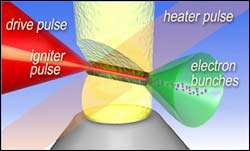This topic covers issues related to energy generation, conversion, transportation and consumption and how the industry is addressing the challenge of energy efficiency in general.
innovations-report provides in-depth and informative reports and articles on subjects ranging from wind energy, fuel cell technology, solar energy, geothermal energy, petroleum, gas, nuclear engineering, alternative energy and energy efficiency to fusion, hydrogen and superconductor technologies.

Researchers at the Department of Energy’s Lawrence Berkeley National Laboratory have taken a giant step toward realizing the promise of laser wakefield acceleration, by guiding and controlling extremely intense laser beams over greater distances than ever before to produce high-quality, energetic electron beams.
For a quarter of a century physicists have been trying to push charged particles to high energies with devices called laser wakefield accelerators. In theory, particles ac

New Environmentally-Conscious Battery Sparks a Revolution in the Watch Market
Sony announced today the launch of the world’s first (as of September 29th, 2004) mercury-free Silver Oxide battery. Considered one of the most difficult challenges within the industry, the introduction of the battery heralds a revolution for millions of watch owners around the world and a major advance for the environment. As a leader in the watch battery market, Sony has utilized its expertise to develo

The University of Alaska Fairbanks and Fuel Cell Technologies of Kingston, Ontario, have announced that the five-kilowatt solid oxide fuel cell installed in Fairbanks has successfully passed the one-year field operational mark.
UAF has been testing fuel cell systems, which convert natural gas to grid-compatible AC electricity, for more than six years. Fuel cells promise highly reliable and efficient small-scale systems for remote power applications that may mean a significant reduc

For the first time, an innovative research technique successfully completed a detailed measurement of how heat energy is created at the molecular level, an approach that could have far reaching implications for developing nano-devices.
Research results to be published in the upcoming issue of Science, detail a collaborative effort involving The University of Scranton, a Jesuit university in Pennsylvania, and the University of Illinois at Urbana-Champaign, a research institution in

For the first time, MIT researchers have incorporated a plant’s ability to convert sunlight to energy into a solid-state electronic “spinach sandwich” device that may one day power laptops and cell phones.
At the heart of the device is a protein complex dubbed Photosystem I (PSI). Derived from spinach chloroplasts, PSI is 10 to 20 nanometers wide. Around 100,000 of them would fit on the head of a pin. “They are the smallest electronic circuits I know of,” said researcher Marc A. Bal

U of T research offers hope for environment
The energy stored in Toronto’s municipal wastewater could be harnessed to run water treatment facilities and contribute power to the city grid, says new U of T research. The study, published in the August issue of the Journal of Energy Engineering, is the first to measure the energy content of the raw municipal wastewater in the Ashbridges Bay, North Toronto, Highland Creek and Humber plants. The research revealed that the wastewater conta